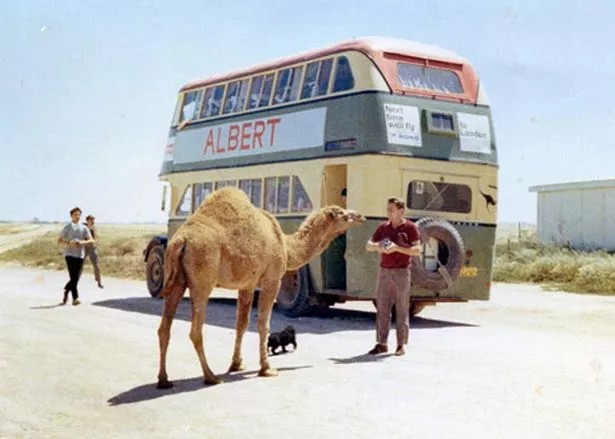In the history of overland travel, few journeys have captured the imagination quite like the legendary London to Calcutta bus service. Operated by Albert Travel, this route offered an extraordinary adventure, spanning continents, cultures, and countless miles. Between the 1950s and 1970s, the bus service connected two iconic cities through an unforgettable expedition, becoming a symbol of exploration, resilience, and the spirit of adventure.
I have to admit that when I first read about this, I wasn’t sure it was real. It seemed a little too bizarre to be true, especially the idea that it was a regular service that operated for over two decades. Why has no-one made a film about it?
Unlike most of my blogs, I felt I had to include pictures in the text to illustrate the outrageous idea of such a bus route, and to prove it actually happened. I’m just sorry I didn’t know about it before the service closed. I might have been tempted…although 50 days on a bus, with other people, conjures up all sorts of nightmares!
The inception of the London to Calcutta bus service can be traced back to the post-war era, a time marked by a burgeoning fascination with travel and discovery. Albert Travel, under the guidance of its visionary founder Albert Padgham, sought to create a travel experience that was as enriching as it was audacious. The maiden journey set out from London on April 15, 1957, and arrived in Calcutta on June 5, taking 50 days to cover over 10,000 miles (16,000 km), one way.

The journey from London to Calcutta passed through England, Belgium, West Germany, Austria, Yugoslavia (now Croatia, Bosnia and Herzegovina, and Serbia), Bulgaria, Turkey, Iran, Afghanistan, Pakistan, and India. After entering India, the bus reached Calcutta via New Delhi, Agra, Allahabad, and Banaras. Each segment of the route presented unique challenges, from navigating the rugged terrains of the Middle East to dealing with the bureaucratic intricacies of cross-border travel.
Despite the hurdles, the bus service maintained a remarkable degree of reliability and safety. The itinerary included stops in historic cities such as Istanbul, Tehran, Kabul, and Lahore, allowing passengers to immerse themselves in diverse cultures and landscapes.
Traveling on the London to Calcutta bus was no ordinary experience. The bus itself was equipped with amenities designed to provide a modicum of comfort on the long journey. Passengers could expect sleeping berths, a small kitchen for basic meals, and storage for their belongings. The cost of the trip one-way was £85 in 1957 (equivalent to £2,589 in 2023) and £145 in 1973 (equivalent to £2,215 in 2023). This amount included food, travel, and accommodation.

One passenger, Peter Moss, recounted in his memoirs the incredible sense of camaraderie that developed among the diverse group of travelers. “We were from all corners of the globe,” he wrote, “yet the bus became our shared home, and the journey bonded us in ways we never imagined.” Another traveller, Jane Owen, remembered celebrating her 30th birthday somewhere in the Iranian desert, with her fellow passengers improvising a cake made out of biscuits and jam.

Each trip was a microcosm of global diversity, bringing together individuals from various backgrounds united by a common desire for adventure. Stories of the road were shared, friendships were forged, and the spirit of discovery prevailed. The bus service was as much about the journey as it was about the destination, offering an unparalleled opportunity to witness the world’s rich tapestry up close.
Eyewitness accounts from passengers provide a vivid picture of life on the road. Bill Meredith, who traveled on the bus in the late 1960s, shared his experience in an interview: “Crossing into India was like stepping into another world. The sights, sounds, and smells were overwhelming, but in the best possible way. We spent hours wandering through bazaars, tasting local food, and absorbing the vibrant culture.”
Barbara Holmes, another adventurer, reminisced about the thrill of navigating the Khyber Pass. “The narrow, winding roads and sheer drops were terrifying, but the views were breathtaking. It was a white-knuckle ride, but one I’ll never forget,” she said. These firsthand stories highlight the mix of excitement and challenge that characterised the journey.
The London to Calcutta bus service thrived during an era when overland travel was imbued with a sense of romance and daring. However, geopolitical changes, the advent of affordable air travel, and increasing political instability in some regions along the route eventually led to the service’s decline.
After some years the bus met with an accident and became unusable. It was purchased by Andy Stewart, a British traveller, who rebuilt it, in Australia, into a mobile home with two levels and renamed it Albert. This double-decker bus travelled from Sydney to London via India on October 8, 1968, taking about 132 days to reach London.
Albert Tours was a company based in England and Australia and operated on the London–Calcutta–London and London–Calcutta–Sydney routes. The bus reached India through Iran and then traveled to Singapore through Burma, Thailand, and Malaysia. From Singapore, the bus was transported to Perth in Australia by ship, and from there it travelled by road to Sydney.
The service charged £145 for the trip from London to Calcutta and included all modern facilities as before. However, it was discontinued in 1976 due to political conditions leading up to the Iranian Revolution and the escalation of tensions between Pakistan and India.

Albert Tours completed about 15 trips between Calcutta and London, and again from London to Sydney before the service ended permanently.

Despite its cessation, the legacy of the London to Calcutta bus service endures. It remains a testament to a bygone era of travel, a time when the journey was as significant as the destination. The tales of those who embarked on this epic voyage continue to inspire modern-day adventurers and serve as a reminder of the extraordinary possibilities that await those willing to venture off the beaten path.